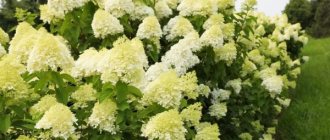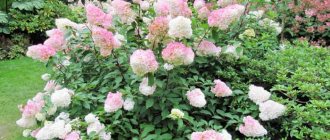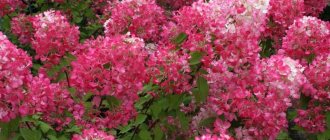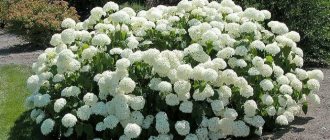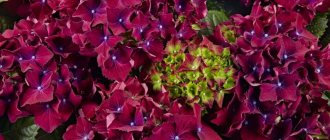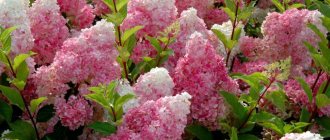General characteristics of large-leaved hydrangeas. Hydrangea Endless Summer
Photo of large leaf hydrangea
Absolutely any variety of hydrangea is a perennial shrub that overwinters in open space and gives a beautiful appearance during the flowering period throughout the summer. But differences between different types of hydrangeas still exist, in form and color. But their main difference from each other is on which shoots they bloom. Due to this, there are differences in their care. There are several varieties of hydrangea:
- Chereshkova. It looks like a weaving vine that wraps around vertical supports. It does not grow as a shrub, compared to other species.
- Paniculata. Has the ability to bloom on new branches grown in the current season. The inflorescences are white and pyramidal in shape. That is why in the autumn they prune it, quite briefly, leaving it to survive the winter period with only the roots of the plant being insulated.
- Tree-like. It is endowed with similar properties as the previous species, although it differs from it in the form and shade of the inflorescence. Has the ability to change color from white to green during one season.
- Large leaf. It is distinguished by rather bright, round-shaped inflorescences. It may bloom on last year's shoots. These varieties do not need heavy pruning. In the autumn, it is necessary to cover not only the root system, but also the branches, having previously bent them towards the soil. Because buds are subsequently formed on these branches, from which, accordingly, after removing the cover in the spring, flowers will form. It is imperative to protect the kidney from freezing. Because otherwise there will be no flowers, even though new shoots will grow.
Among large-leaf hydrangeas, the Endless Summer variety has gained particular love and popularity. It differs primarily in that flowers form on absolutely all shoots, whether new or last year’s. This can only mean that with high-quality care for the plant, it will produce lush and abundant color throughout the entire season, from the very beginning of summer until late autumn. This variety has another name - Endless Summer.
Landscape: use in decorating gardens, flower beds
A spectacular and lush variety of hydrangea Blooming summer can become a real decoration for any garden or summer cottage. Constant flowering throughout the summer season allows you to use hydrangea for decorative purposes.
Hydrangea Magical Moonlight - variety description, planting and care
This bright winter-hardy shrub is planted nearby, lining it with a flowering fence or hedge. But this plant is also planted as single shrubs to decorate a summer cottage. In one flower bed, as a rule, plants with different shades of inflorescences are combined.
Attention! The Summer Love hydrangea is considered a good neighbor for this variety. These two varieties bloom in different shades, creating diversity in the flowerbed.
The large-leaved hydrangea shrub is the most amazing representative of ornamental plants, as it is distinguished by lush and spectacular flowering. If you choose this flower to plant on your site, you can provide yourself with a beautiful picturesque view throughout the summer season. It is worth noting the simple care and unpretentious conditions for growth.
0 0 votes
Article rating
Large-leaved hydrangea Endless summer: description of the variety
Hydrangea Endless Summer: photo
An important feature of the large-leaved hydrangea Endless Summer is to produce color more than once during the summer period. Of course, this is not a natural feature of hydrangea, but a successful fruit of the work of the scientists who developed it. The garden hydrangea Endless Summer begins to bloom for the first time at the beginning of summer, and the next flowering occurs in the middle of the summer period and continues until the onset of winter cold.
Thanks to this fact, this hydrangea is a favorite plant of our gardeners. An important circumstance of such love and fame among gardeners is that this hydrangea is capable of changing the shade of its flowers. This happens due to the specific composition of the growing soil, which farmers have easily learned to change for their own purposes.
Plus, to all that has been said, this variety does not require enormous and labor-intensive care. He will feel great even with normal care.
Planting hydrangea Endless Summer
Photo of hydrangea variety Endless Summer
First of all, before planting, take care of choosing the right site for it. It should be with enough sun and no drafts. After this you should:
- Dig up the place chosen for growing this shrub quite well, removing all the weeds growing there from such an area.
- Add organic fertilizer to the soil, such as compost, humus, turf, peat.
- Prepare a hole for the plant. The size is such that the root system of the seedling can easily fit there, without any kind of twisting or bending.
- Place a layer of drainage at the bottom of the hole, which is very important for good growing. Small pebbles can be used as drainage; they will prevent water from stagnating.
- The hole is watered, since it is extremely important to plant the plant in moist soil.
- Lower the seedling into the hole, carefully spreading the root system of the young bush. Sprinkle it with nutritious soil, compacting it a little. Water the planted seedling and mulch the soil on top.
- In the first few weeks after planting, keep an eye on the plant and soil. It should not dry out, so irrigate if necessary. Laying mulch will help retain some of the moisture in the soil.
How to plant?
This variety grows well in areas where the sun appears in the mornings or evenings. At noon, there should be a light shadow at the landing site. It is also advisable to choose a place protected from drafts.
The soil should be acidic or slightly acidic. Calcareous soil is not suitable for planting. You should also avoid excessive accumulation of moisture at the roots of the plant. Based on this, the bush should not be planted in lowlands. The best place is on a flat surface or a slight hill.
Endless Summer is planted according to a specific pattern.
- The area allocated for the flower is dug up and the weeds are removed.
- The soil is enriched with organic matter (compost, peat, turf soil, humus).
- They dig a hole. It should be made spacious so that the roots of the crop fit freely in the recess.
- A drainage layer is placed at the bottom of the hole. For example, these could be small pebbles. This measure will prevent moisture stagnation.
- The hole is spilled with clean water. The plant should only be placed in moist soil.
- The culture is carefully lowered and the roots are straightened.
- The planted plant is covered with a nutrient mixture. Then the soil is lightly compacted and watered.
- Lay mulch. You can use pine litter or crushed pine bark. The mulch layer should be about 8 cm. This will maintain an optimal level of soil moisture and reduce the likelihood of weed germination.
Basic care rules
Hydrangea Endless Summer: photo
For the garden hydrangea of the Endless Summer series, as for any perfect plant, timely care is required. Moreover, care measures with their own characteristics should be applied to each type. Let's consider the care conditions required for growing this species:
- choice of a site very seriously . It must be chosen taking into account all the needs of the plant. Namely: with a sufficient level of lighting and sheltered from gusty winds. But it is worth considering that direct sunlight hitting the plant during lunch hours can harm it: leave a burn. Therefore, it is important that the planting site is located in such a way that the sun illuminates the hydrangea in the morning and afternoon.
- Plant-friendly soil composition . Absolutely all types of this shrub want to grow in slightly acidic or acidic soil. Calcareous soils are an extremely bad option for them. Keep this in mind when fertilizing with a certain fertilizer composition. Although these shrubs tolerate moisture well, stagnation of water at the roots must be avoided to avoid infection with rot. Based on this, a site located in the lowlands will also be a bad option for hydrangea. The best option would be a low elevation.
- Regular watering . As already mentioned, all these shrubs love moisture, but not too much of it, remember this. You need to carefully monitor the condition of the soil at the roots. It should always be moisturized. This is especially true for young plants just planted in a new place of growth.
- A mandatory procedure for fertilizing with fertilizers, especially those based on potassium. In the summer, superphosphate is added to the soil, which is also very important for this shrub. If your goal is to change the color of the inflorescences, then you need to add ammonium sulfate to the hydrangea growing soil. But only after the first flowering period, when the plant’s inflorescences are pink. If you perform this feeding approximately in the middle of summer, as a result, in the next flowering period, your hydrangea will delight you with a blue tint of inflorescences.
In addition to all of the above, this plant requires regular loosening along with weeding from weeds, which spoil the appearance of this shrub and take away nutrients and moisture from it. Therefore, do not forget about this procedure, which is also considered extremely important for the growth and development of hydrangea.
Peculiarities
The variety Endless Summer or “Eternal Summer” appeared in the USA. In the 80s of the last century, this country experienced an abnormally cold winter. In one of the nurseries, a large number of crops were lost due to freezing. However, in the spring, in a neighboring garden, the organization’s employees noticed a hydrangea that looked great and bloomed, despite the frosts it had experienced.
The plant was noted. A couple of years later, experts planted a cutting of this bush in a nursery. The flower turned out beautiful and healthy. It also tolerated low temperatures quite steadfastly.
For about 20 years, breeders have tried to further improve the characteristics of the crop. In the 2000s, the appearance of a new variety was officially announced, although work is still underway today. The main task is to increase the frost resistance of the variety. Experts are also working on decorative characteristics, although the beauty of the plant is beyond doubt.
The most interesting feature of the bred variety can be considered the ability to bloom again. This is what explains its name. While some crops lose their petals, turning into ordinary greenery until next year, this variety of hydrangea can more than once please the gardener with lush, bright “caps” of flowers. In this case, the color of the petals may change depending on the composition of the soil. This mutation makes the culture even more interesting and desirable for many summer residents.
The description of the variety should begin with the fact that it is a large-leaved, rather tall hydrangea. The culture can grow up to two meters or more. The shoots are strong and flexible. The leaves are dark green, matte, and have toothed edges. The green stems of young plants darken as they grow. And also a kind of bark is formed on them. The bush turns out to be round and neat, although its diameter can reach up to one and a half meters.
“Eternal Summer” begins to bloom already in the second year of life, which few varieties can boast of. The inflorescences are luxurious, large, spherical in shape. Can reach 15 cm in diameter. The color of the petals can be pinkish or pale blue. The shade is adjusted by changing the pH of the soil.
Pink flower “caps” are obtained when the bush grows in alkaline soil. Blue-blue flowers are produced in acidic soil enriched with aluminum.
The plant is perennial. With proper care, it tolerates winter well and forms new shoots by spring. Flowers appear both on them and on last year’s stems. The bush blooms every 6 weeks, so in one summer buds appear twice, and sometimes three times.
To date, several new varieties of hydrangeas have been created on the basis of this variety.
- Endless Summer Bloom Star is a tall bush (up to two meters) with blue sterile flowers. The bush blooms 2-3 times during the summer. Flowering begins in June and ends only with the onset of frost.
- Endless Summer Blushing Bride is a more compact variety. The maximum height of the bush is 1.2 m. The flowers are semi-double. At first they are snow-white. Then the color becomes soft pink (if there is alkali in the soil). If the soil is acidic, the petals turn pale blue.
- Endless Summer Twist-n-Shout - can also grow up to 1.2 m. The flowers in the center of the inflorescence are small in size. They are fruit bearing. Larger sterile flowers are located along the edges. The appearance of the plant is very impressive. Depending on the level of soil acidification, the color can vary from pink and purple tones to blue with a violet tint and sky blue shades.
Hydrangea Endless Summer: pruning and care rules
Photo of hydrangea variety Endless Summer
You will not feel any particular difficulty in caring for the Endless Summer hydrangea; it is completely similar to caring for other varieties of this shrub. In order for your plant to grow and develop beautifully, and also to please you with its excellent and gorgeous flowering, you only need to carry out such actions as loosening, watering and weeding, and of course complex fertilizing in a timely manner.
The most important thing in care is the procedure for pruning the Endless Summer hydrangea and insulating the bush for the winter. Just keep in mind that you absolutely cannot prune this shrub too much, since future inflorescences can be cut off at the same time as the branches. Accordingly, there can be no talk of any decorativeness. This procedure should be carried out on already very overgrown shrubs.
In the first years of life, there is no need to form bushes and trim them. It is necessary that their lashes grow at a calm pace. Numerous flower buds will form on them in the future. The procedure for pruning the Endless Summer hydrangea should be carried out as follows:
- In the autumn period of the year, all dried and damaged branches are cut off to the very base, and along with them the old stems that have stopped flowering. Do not start the plant until it becomes very thick.
- The remaining branches are shortened, but not much.
- Before the first frost, long stems are bent to the soil, having previously placed insulation under them, this can be plywood, board or cardboard. And on top of these stems they are covered with a special material that can allow air to pass through, and sprinkled with fallen leaves.
- This entire structure needs to be well secured, for example, with metal arches. This is done so that the wind cannot blow away all the leaves before the first snow falls.
With the arrival of spring, as soon as it gets warmer, you should remove this shelter from the bush, as damping off of the stems may occur. After all, moisture and sun, if we take into account the presence of shelter, can destroy flower buds.
When growing in places where severe frosts are observed at night, the shelter should not be removed immediately, but gradually. But when the moment comes when the sun begins to warm up enough, the covering material along with the foliage must be completely removed from the bush. The stems should not be lifted. They will rise on their own and take the position that they themselves need.
Next, you should trim the frozen shoots of the Endless Summer hydrangea variety. Moreover, this must be done right down to the living tissue, so that a situation does not arise when the plant becomes sick due to the rot of the branches that thaw.

